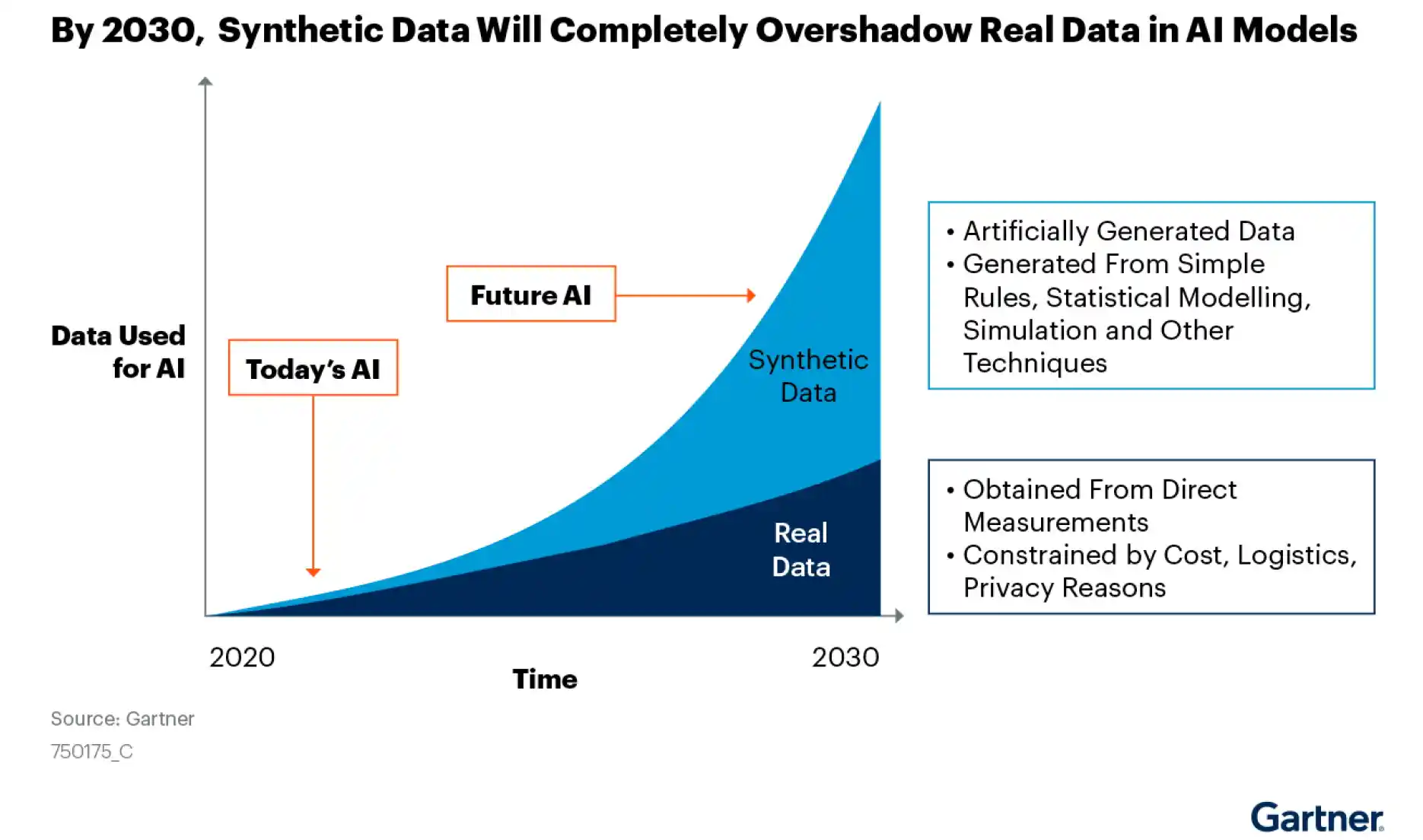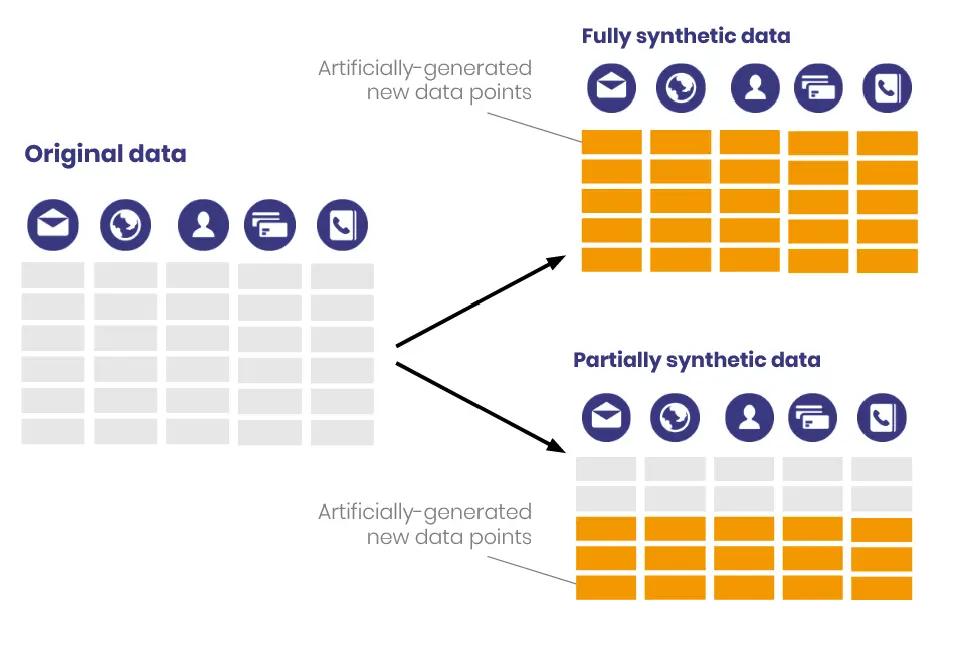What is synthetic data? What are its uses and benefits?

Data is everything in today’s modern world. Synthetic data can offer a cost-effective and viable method even if it might be costly and time-consuming to gather. Because it can be utilized for tasks like testing different products, verifying algorithms, and training AI models, synthetic data is frequently a better choice than gathering real data. Today, Businesses are using data-centric methods for developing AI and ML, including synthetic data, to address the issues. Let’s get more into deep about synthetic data.
What is synthetic data?
Synthetic data is information that is produced artificially rather than by genuine methods. It is frequently developed with the use of algorithms and is applied to a variety of tasks, such as test data for new tools and products, model validation, and training AI models. One sort of data augmentation is synthetic data.
Types of synthetic data
In order to conceal sensitive personal information and preserve statistical details of features in the original data, synthetic data is generated at random. Three categories can be used to broadly classify synthetic data:

Types of synthetic data
Fully synthetic data: This data is entirely generated; no authentic data are there. As a result, it is nearly impossible to re-identify any particular unit, yet all parameters are still completely available.
Partially synthetic data: Only sensitive data is substituted with synthetic datasets; the rest is partially synthetic. The imputation model must be heavily relied upon for this. Due to the real values that are still there in the dataset, this results in a reduction in model dependence, but it also means that some exposure is feasible.
Hybrid Synthetic: Data that is both real and synthetic are combined to create hybrid synthetic data. The fundamental distribution of the original data is examined, and the nearest neighbor of every data point is created while ensuring the relationship and consistency between several variables in the dataset. To create hybrid data, a near-record from the synthetic data is selected for each record from the real data.
Importance of synthetic data
The power of synthetic data to provide features that otherwise wouldn't be possible with real-world data makes it crucial for a variety of applications. Synthetic data is a lifesaver when real data is scarce or when maintaining anonymity is of the utmost importance.
The artificial intelligence (AI) business industry is heavily dependent on this data.
- For assessing some disorders and circumstances when genuine data is lacking, the healthcare and medical industry use fake data.
- Artificial data is used to train self-driving Uber and Google vehicles.
- Fraud protection and detection are of utmost importance in the financial sector. Synthetic data can be used to investigate new fraudulent situations.
- Data professionals can access and utilize centrally stored data while still protecting its anonymity thanks to synthetic data. Synthetic data has the ability to mimic the key characteristics of genuine data without divulging its true meaning, maintaining privacy.
- In the research division, synthetic data enables you to create and offer cutting-edge goods for which the essential data might not otherwise be accessible.
Benefits of synthetic data
Full user control over synthetic data
In a simulation using synthetic data, everything is controllable. It has both blessings and drawbacks.
Because there are instances where edge circumstances that can be recorded in real datasets are missed by synthetic data, it can be a curse. You might wish to use transfer learning for these applications to mix some actual data with the synthetic datasets.
However, this is also a benefit because you may choose the event frequency, item distribution, and much more.
The annotation of synthetic data is flawless
The flawless annotation offered by synthetic data is another benefit. Never again will manual data collection be necessary.
Each object in a scene can automatically create a variety of annotations. This might not seem like a significant concern, but it's a major factor in the low cost of synthetic data in comparison to real world data. The labelling of data is free. Instead, the initial expenditure in creating the simulation is the primary cost of using synthetic data. The cost-effectiveness of creating data over genuine data increases rapidly after that.
Synthetic data is generally multi spectral
Companies that manufacture autonomous vehicles have learned how difficult it is to annotate non-visible data. They have therefore been among the strongest supporters of synthetic data.
Many businesses produce fictitious LiDAR data using simulations. Because it is synthetic, the data is already categorized and the ground truth is known. For computer vision applications using infrared or radar imaging, when humans can't completely interpret the imagery, synthetic data works well.
Use cases of synthetic data
The original data that it augments should be faithfully represented by the synthetic data. In a non-production setting, high-quality synthetic data can take the place of real, sensitive production data (i.e., training models, testing, analysis, development, etc.).
Data scientists can comply with data privacy laws like HIPAA, GDPR, CCPA, and CPA with the aid of synthetic data. For using sensitive datasets safely for testing or training, synthetic data is excellent. From such data, businesses can gain insights without jeopardizing privacy compliance.
Synthetic data's typical use cases include:
- Synthetic testing data is more flexible, scalable, and realistic than regulation test data and is simpler to create for testing. The development of software and data-driven testing both depend on this information.
- Training AI/ML models — The training of AI models increasingly uses artificial data. Real data can be supplemented using data synthesis, which can upsample uncommon events or patterns and improve algorithm training. In general, synthetic training data outperforms real-world data and is essential for creating superior AI models.
- Synthetic data for governance helps eliminate biases in real-world data. In order to stress test an AI model with data sets that hardly appear in the real world, dataset is also helpful. Artificial data is necessary for AI that can be explained and offers understanding of model behavior.
If you are looking for synthetic data to use in your research, or for developing an algorithm for your project, then we at Labellerr helps you by providing the synthetic datasets. We are also efficient in training data models as we are a data training platform with an experienced team of annotation experts to support you at a higher level. To scale your AI and Machine learning project, we highly recommend you use high-quality data.
To know more about such information, stay updated!
Book our demo with one of our product specialist
Book a Demo
